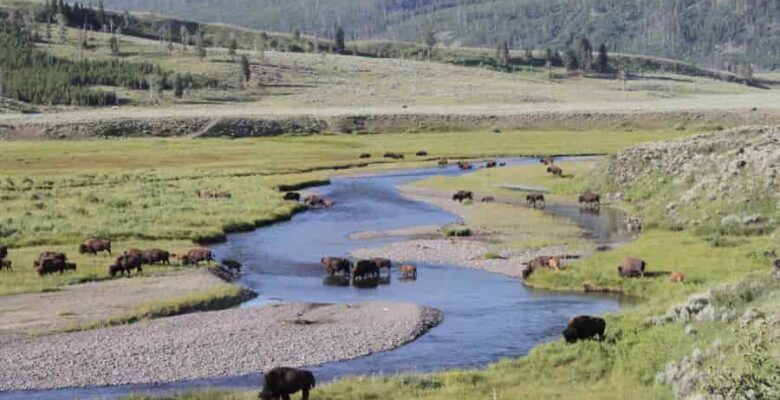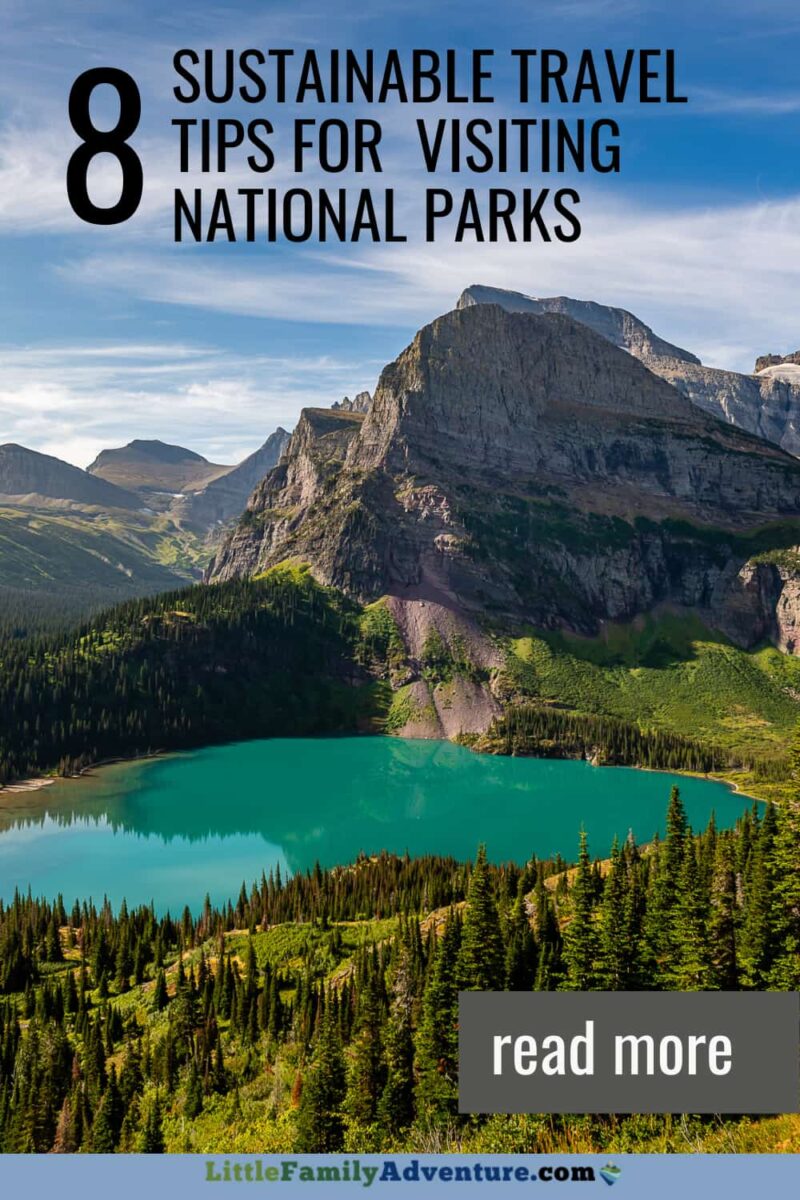There’s nothing quite like gathering the family together for a good, old-fashioned road trip. Whether you’re packing up the RV or just want a summer vacation you’ll never forget, heading to some of the country’s best national parks is a great way to appreciate nature, learn more about U.S. history and bond with your family.
When you’re visiting a national park, it’s easy to be in awe of the natural beauty surrounding you. As you keep that in mind, consider how important it is to be as sustainable as possible while you travel.
This article contains affiliate links. We earn from qualifying purchases.
If you’re trying to boost your sustainability efforts every day, you’re certainly not alone. As we face societal issues like global warming, greenhouse gas emissions, and excess waste, more people are starting to realize the importance of sustainability and are willing to do their part. While you might not initially think travel and “going green” could possibly be connected, there are plenty of things you and your family can do to navigate sustainable travel.
Let’s look at some of the most incredible national parks you should visit within the country, and how you can set up sustainable travel while you’re on the road and while you’re camping.

Where to Visit
There are 424 national park sites in the United States. While you might not be able to visit them all, you really can’t go wrong with any of them, depending on what you’re looking for. Some are more easily accessible than others. Some are better suited for families with young kids, while others are perfect for adrenaline junkies looking for adventure.
If you’re traveling to a national park in an RV or car, you’ll enhance your experience by making the journey just as enjoyable as the destination. Some of the best national parks that are worth the drive include:
- Death Valley National Park: If you’re looking for everything from ghost towns to rocky mountain passes, look no further. Death Valley might have a “frightening” name, but it offers some of the most interesting structures in the country, including Dante’s View.
- Capitol Reef National Park: While Capitol Reef is a beautiful park, you’ll likely be most excited about the drive in. On Highway 12, you’ll see Cottonwood Canyon and Hell’s Backbone before looking in awe upon the Grand Staircase-Escalante National Monument.
- Glacier National Park: This park is famous for its natural roadside attractions, including Lake McDonald, the Trail of Cedars, and Going-to-the-Sun Road. It might be impossible to cover more than a million acres within the park, but you’ll have plenty of opportunities to pull over and enjoy its natural beauty.
- Big Bend National Park: Big Bend is home to the only mountain range in the country housed entirely within a national park. Because of that, it’s the perfect place for just about any outdoor adventure you could imagine, from hiking and biking to river rafting.
- Arches National Park: Home to the famous “Balanced Rock”, Arches National Park features many incredible structures that don’t require you to leave your vehicle to see. You can also get out and hike along the rocky terrain, but it’s a park more suitable for experienced hikers.
As you travel to these destinations, you’ll see some of the most beautiful landscapes the country has to offer. As you plan your trip, don’t be afraid to take the scenic route. The more you take the time to enjoy nature and the world around you, the more motivated you’ll become to live sustainably.

Sustainable Travel Tips
While traveling in a car or RV might not seem like a “green” way to travel, there are plenty of ways to cut back on your carbon emissions and live more sustainably on the road.
Before you hit the road, make sure your vehicle has had a tune-up and is well-maintained. Vehicle maintenance helps the environment by making your car run more efficiently. You’ll reduce your carbon emissions and could end up saving money. Once you’ve taken your car to a mechanic, get ready for your trip by:
- Packing light to maximize fuel efficiency
- Bringing reusable water bottles and containers
- Planning your route in advance
- Offsetting your trip by getting involved in conservation efforts
Consider packing as many snacks and beverages as possible, too, so you won’t have to rely on things like fast food and gas station snacks. Not only will you save money, but you’ll do your part to reduce the need for mass manufacturing, and you’ll stop your vehicle less often.
While driving, use the cruise control as often as possible to avoid pressing on the accelerator. Keeping at a steady, consistent speed will create less wear and tear on your car, and will cause you to use less fuel. You can also coast behind a truck or another large vehicle. The natural “pull” from their vehicle will help you cruise along a bit faster without having to add any more pressure onto the pedal. It’s a great way to save a bit on gas if you’re not in a hurry to get to your destination.
Green Camping
Once you’ve reached the park of your choice, you’re probably going to stick around for a while. Camping in one of our country’s national parks is an experience you’ll never forget, and you can make it a “green” one for the whole family.
First, take advantage of any park resources designed to promote sustainability. That could include everything from recycling bins to immersive eco-friendly tours. While your family vacation should be fun, it can also be a learning experience – especially for your kids. It’s essential for them to understand the importance of a sustainable lifestyle, so they can foster a cleaner planet for their generation and beyond.
When you’re making your way around the parks, opt for shuttle systems, walking, hiking, or biking instead of using your car to get around. The shuttles are designed to take you on the best routes to reach different destinations. Plus, most of them run on clean, compressed natural gas.
Additionally, you’ll take the time to appreciate your surroundings if you go on foot or bike around the parks. Plus, doing so will give you the opportunity to spend more time immersed in nature. That isn’t just good for the environment, it’s good for your mental and physical health. Some of the biggest health benefits of spending time outdoors include:
- Reduced stress
- Boosted energy
- Feelings of happiness
- Lower blood pressure
Once you head back to your campsite for the day, you can continue to do things sustainably by disposing of waste properly, respecting wildlife, leaving anything you find in its place, and minimizing the effects of your campfire by using a fire pan or fire blanket, spreading out your ashes, and eventually restoring your fire site to its previous appearance. Since campfires release carbon into the air, you might want to forego that option completely. Consider alternatives like propane stoves, LED lights, or artificial fires.
Whether you’re camping with a teenager or you’re bringing a baby along with you, you can use the experience as a way to teach your kids the importance of conservation and green living.
Finally, no matter where you are in the parks, keep some best practices in mind for boosting your sustainable efforts, including:
- Bringing a reusable water bottle when you’re hiking
- Asking about local recycling centers
- Reducing food waste and composting when possible
- Never littering
Even if you’re not camping in a tent or RV, you might be able to rest your head comfortably and know you’re doing something good for the environment by staying overnight in a green building. Parks like Yellowstone and Zion offer Grean-Seal-certified hotels. A building can only be Green Seal approved if it focuses on waste minimization, energy conservation, pollution prevention, and wastewater management. Many of these hotels are doing their part to reduce their carbon footprint and educate guests on the importance of sustainability. If you can’t camp on your own, these lodgings are the next best solution.
Can’t read now? Pin for later!

When to Visit
There’s no “bad” time to visit one of our country’s national parks. However, most people tend to go in the spring and summer when kids are out of school and the weather is nicer. There’s absolutely nothing wrong with planning a summer road trip with the family and heading to as many parks along the way as possible.
However, traveling during the off-season can be good for you and the planet.
In the height of the summer, many of the country’s popular national parks can become overcrowded. Waste and garbage can build up, rates can increase for nearby attractions, and you might not be able to fully experience the beauty of the nature that surrounds you when you’re surrounded by crowds.
Traveling during the fall and winter months is often more cost-effective, less stressful, and better for the environment. There’s less mass consumption, so important resources don’t have to be stretched so thin all at once. Additionally, less air pollution and garbage take some of the “stress” off of the planet, giving things time to heal and regenerate. From a personal standpoint, you’ll also have more time to walk around, do things at your own pace, and enjoy the peace of the parks when there are fewer people there.
What’s the point of navigating sustainable travel? There are lessons to be learned, especially when you’re heading to a national park. By putting these tips into practice, you’ll teach your children the importance of sustainability, and you might even feel better as you remind yourself more frequently.
Furthermore, sustainable travel has long-term positive impacts. If more people decided to road trip sustainably, there would be fewer cars on the road and fewer emissions released. Even if you choose to fly to your park destination, don’t hesitate to do your research on airline companies promoting sustainability. Many of them have launched new initiatives to help their passengers feel more comfortable, secure, and eco-friendly on every flight.
Everyone should have the opportunity to see our country’s national parks at least once. There’s no reason you can’t take your sustainability efforts on the road as you enjoy all nature has to offer. Being in these parks will remind you why it’s so important not to take them for granted. As you bring your kids along with you, they might act like they’re bored or wonder what happens next, but rest assured – they’re watching your actions, and learning what’s important by how you follow up.
For more outdoor activity inspiration, check out our latest posts here:
- 10 Great Audiobooks to Listen to While Hiking
- The Best Sunglasses for Men: Combining Function and Fashion for Ultimate Comfort
- 25 Cool Camping Gifts Any Outdoorsy Person will LOVE
- Ultimate List of 34 Outdoor Games For Teenagers
FOLLOW US ON SOCIAL MEDIA
- Facebook Page
- Family Adventures Facebook Group
- Easy Camp Cooking Facebook Group
Don’t forget to invite your friends to our Facebook groups! We would also love to see your vacation pictures!



Road trips to national parks are the best! I love how this article highlights sustainability. It makes me think of our camping trip to Yellowstone. We tried to leave no trace, but it was tough. How can we make RV travel more eco-friendly? And which park is most underrated for sustainable adventures?